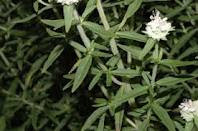MALABAR NUT, JUSTICIA ADHATODA
The Malabar nut plant is an evergreen shrub, which is native to the Indian subcontinent and Sri Lanka . As a member of the Acanthaceae family it is related to the marsh barbell and to bear’sbreeches or the oyster plant. All parts of the plant are used in traditional medicine systems in Asia and it has also been used in Europe for centuries.
 The flowers on this plant look like those of bear’s breeches, but are more reminiscent of foxglove flowers than those of the snapdragon. The flowers contain an impressive array of flavonoids (among them apigenin, kaempferol and quercetin), which give them antioxidant properties and these flowers are used for colds, asthma, bronchitis, coughs, as an antispasmodic, for fevers and gonorrhoea. They also have antiseptic properties and are used to improve blood circulation.
The flowers on this plant look like those of bear’s breeches, but are more reminiscent of foxglove flowers than those of the snapdragon. The flowers contain an impressive array of flavonoids (among them apigenin, kaempferol and quercetin), which give them antioxidant properties and these flowers are used for colds, asthma, bronchitis, coughs, as an antispasmodic, for fevers and gonorrhoea. They also have antiseptic properties and are used to improve blood circulation. The root decoction of the plant is used to treat T.B., diphtheria, malaria, leucorrhoea, eye problems and gonorrhoea. An extract of the root is also used for liver problems, especially for jaundice, for diabetes, and coughs.
Preparations include a paste, and powder as well as the root decoction.
Chewing the leaf bud, either alone or with a little ginger root is said to clear the respiratory passages, and is used by yogis before a rigorous exercise programme is undertaken.
The fruit or the ‘Malabar nut’ is used for colds, as an antispasmodic, for bronchitis, jaundice, diarrhoea and dysentery, fever and as a laxative.
The leaves are a rich source of vitamin C, and also contain carotene and essential oil and are used in various ways. In parts of India they are used to induce an abortion and are given after childbirth to help staunch bleeding and to tone the uterus. They should not be used during pregnancy or by breast-feeding mothers. Powdered leaves are a counter-irritant for inflamed swellings and are also used on fresh wounds and for neuralgia.
The dried leaves are sometimes smoked in the treatment of asthma. The fresh sap from the leaves is used for bleeding gums, diarrhoea and dysentery, glandular tumours, and T.B. When burnt, they have insect repellant or insecticidal properties.
The leaves are also given to lower high blood pressure, and in Germany they are used for their expectorant and antispasmodic properties in coughs colds and so on.
In Sweden they are categorized as a natural remedy and can be found with other natural ingredients in cough medicines.
The leaf powder boiled in sesame oil, is used to staunch bleeding and is used as ear drops for ear aches. The warmed leaves are used as poultices for the pains of rheumatism and dislocated joints.
The plant contains quinasoline alkaloids including vasicine and vasicone, and these are currently under investigation to discover their properties and potential for new drugs.
In “A review of Justicia adhatoda: A potential source of natural medicine” Sandeep Dhankhar et al. African Journal of Plant Science, Vol. 5 (4) pp. 620-627, it is suggested that “extract of J. adhatoda could form one of the best options for developing novel natural medicines”.
(Adhatoda is said to mean “goats don’t touch” in Malayalam, as they avoid this plant allegedly.)


















